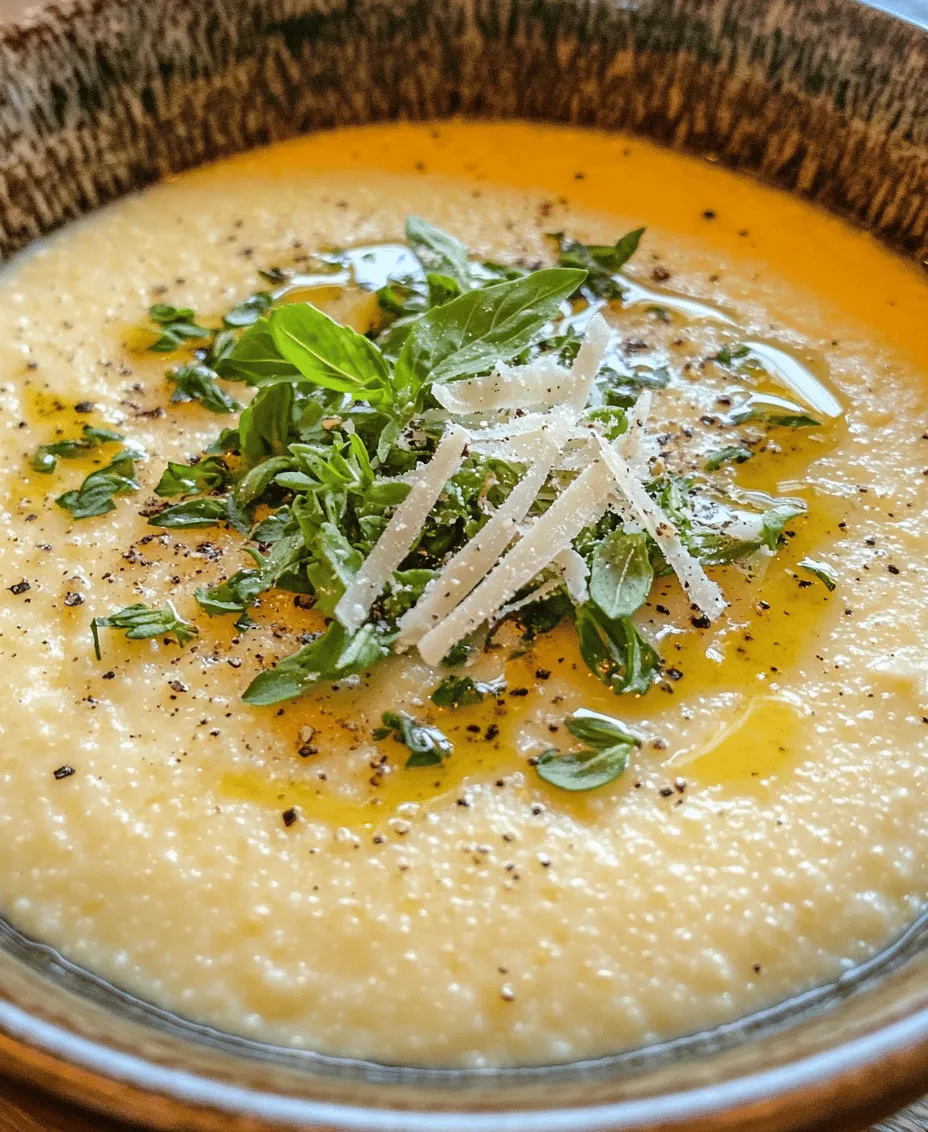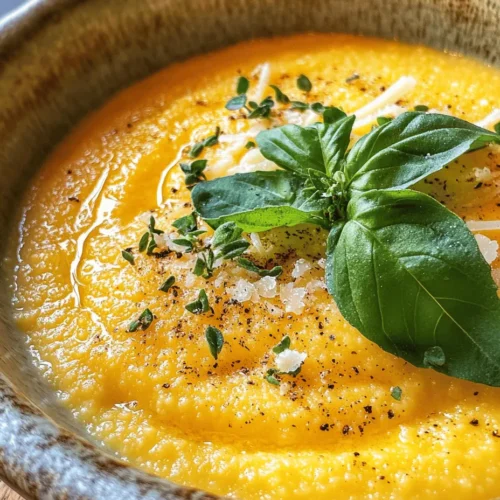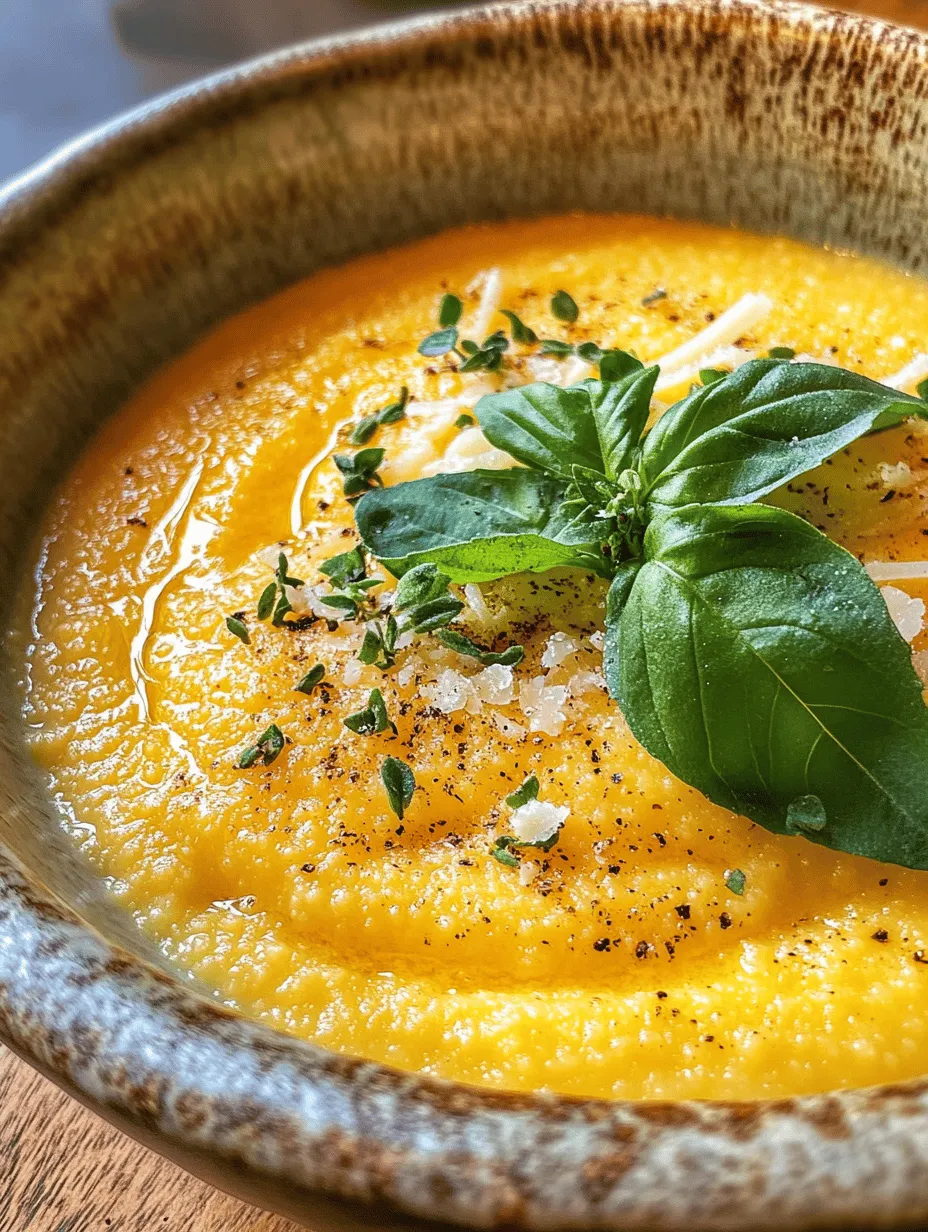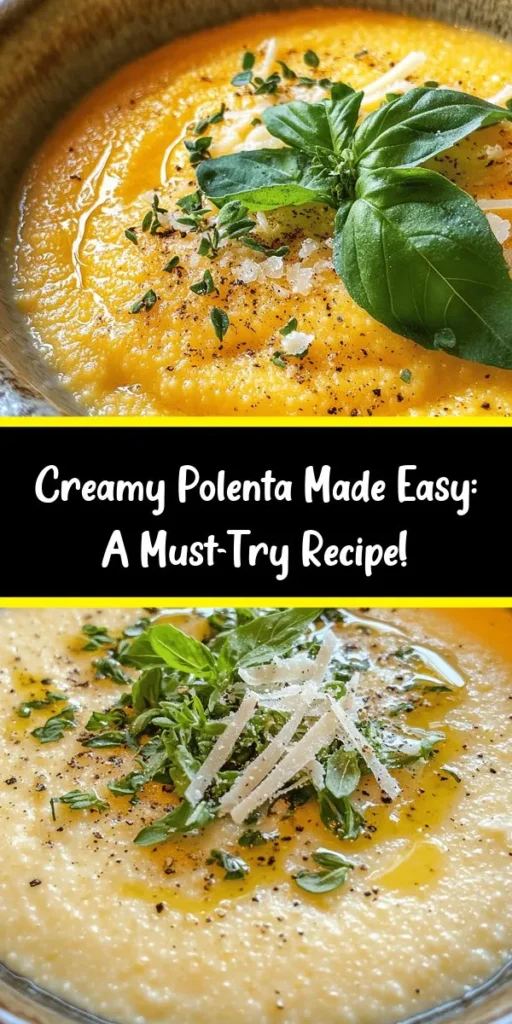Introduction to Perfectly Creamy Polenta
Polenta, a staple of Italian cuisine, is a dish that has stood the test of time. With its origins deeply rooted in Northern Italy, polenta has evolved from a humble peasant food to a beloved dish worldwide, celebrated for its creamy texture and versatility. Made primarily from ground cornmeal, polenta can be served in various forms—creamy, sliced, or even grilled—making it an ideal base for a multitude of toppings, sauces, and accompaniments.
The allure of polenta lies not only in its adaptability but also in its rich culinary history. Traditionally, polenta was made with yellow cornmeal, but over the years, variations have emerged, incorporating different types of grains and flavorings. Today, polenta is embraced by chefs and home cooks alike, appreciated for its ability to absorb flavors, providing a perfect canvas for both savory and sweet dishes. Whether paired with a hearty tomato ragu, sautéed mushrooms, or topped with fresh herbs and cheese, polenta can cater to diverse palates and dietary preferences.
Making polenta from scratch offers numerous benefits. The act of preparing polenta allows you to appreciate the transformation of simple ingredients into a creamy, comforting dish. When cooked properly, polenta boasts a velvety texture that store-bought alternatives simply cannot replicate. Additionally, the flavor of fresh, homemade polenta is richer and more satisfying than pre-packaged versions, providing an authentic experience that connects you to traditional cooking methods.
Understanding Polenta: A Culinary Staple
The origins of polenta date back centuries, with its roots tracing to the ancient peoples of the Italian peninsula who relied on ground grains for sustenance. Initially, polenta was made from farro, chestnuts, or even millet, but as corn became widely cultivated in the Americas, it became the primary ingredient for this beloved dish. The introduction of cornmeal revolutionized polenta, allowing for its rise in popularity among all social classes.
In traditional Italian cooking, polenta was often served as a side dish or a base for meat and vegetable preparations. It was a filling and inexpensive option that could be easily prepared over an open flame. Today, polenta has been embraced globally, with variations found in numerous cuisines. For example, in Brazil, a similar dish known as “polenta” or “fubá” is enjoyed, while in Southern US cuisine, it appears as grits, showcasing the adaptability of this comforting grain.
When it comes to cooking polenta, the type of cornmeal you choose plays a significant role in the final dish. Coarse cornmeal, often labeled as “polenta,” is recommended for achieving the ideal texture. Its larger granules allow for a heartier consistency and a more rustic finish, while finer cornmeal can lead to a mushy result. Understanding the differences in cornmeal types is essential for creating the perfect creamy polenta that retains its structure while still delivering that signature smoothness.
The Benefits of Homemade Polenta
While pre-packaged polenta is readily available in many grocery stores, there are distinct advantages to making this dish from scratch. First and foremost, homemade polenta allows you to control the quality of ingredients you use. By selecting high-quality cornmeal and fresh additives, you ensure a superior flavor profile that enhances the overall dish. Additionally, making polenta at home means you can customize it to suit your taste preferences. Want a richer flavor? Add more butter or cheese. Prefer a vegan version? Simply skip the dairy.
Another benefit is the satisfaction that comes from preparing a classic dish from scratch. Cooking polenta can be a meditative process, and there’s something rewarding about stirring the pot as the cornmeal thickens and transforms into a creamy delight. This hands-on experience allows you to connect with your food, understanding its textures and flavors as they develop. Moreover, serving homemade polenta to family or friends can elevate a meal, showcasing your culinary skills while sharing a piece of culinary history.
Ingredients for Perfectly Creamy Polenta
To create the perfect creamy polenta, you’ll need a few simple ingredients. Here’s a detailed description of each component and its role in the recipe:
– Coarse Cornmeal: The star of the dish, coarse cornmeal, is essential for achieving that signature creamy texture. Its larger granules provide a heartiness that fine cornmeal lacks, resulting in a more satisfying bite. Look for high-quality, stone-ground cornmeal for the best flavor and texture.
– Water or Broth: The liquid you choose to cook your polenta in is crucial for flavor. While water is a standard option, using vegetable or chicken broth can significantly enhance the taste of your polenta. Broth adds depth and richness, making your dish more flavorful and aromatic.
– Salt: Salt is a key ingredient that elevates the overall flavor of your polenta. Adding salt to the cooking liquid helps to season the cornmeal evenly, ensuring that every bite is flavorful. Be sure to taste and adjust the salt level as needed throughout the cooking process.
– Optional Ingredients: While basic polenta is delicious on its own, there are numerous optional ingredients you can incorporate to take your dish to the next level. Butter adds creaminess and richness, while Parmesan cheese brings a salty, nutty flavor that complements the cornmeal beautifully. Fresh herbs, such as thyme or rosemary, can introduce a fragrant element, and a drizzle of high-quality olive oil can add a luxurious touch. Additionally, freshly cracked black pepper provides a subtle heat that balances the dish.
Step-by-Step Instructions for Cooking Polenta
Now that you have a solid understanding of polenta and its ingredients, let’s dive into the step-by-step instructions for cooking your perfectly creamy polenta. This process is straightforward and rewarding, leading to a dish that can be enjoyed in various ways.
1. Prepare Your Ingredients: Gather all your ingredients and tools. You’ll need a heavy-bottomed pot or saucepan, a whisk or wooden spoon for stirring, and a measuring cup for your cornmeal and liquid.
2. Bring the Liquid to a Boil: In your heavy-bottomed pot, combine the water or broth and salt. Bring the mixture to a rolling boil over medium-high heat. Make sure to stir occasionally to prevent any sticking.
3. Add the Cornmeal: Once the liquid is boiling, gradually whisk in the coarse cornmeal. It’s crucial to add the cornmeal slowly while continuously whisking to avoid clumping. This will help create a smooth, lump-free texture.
4. Reduce Heat and Simmer: After incorporating the cornmeal, reduce the heat to low. You’ll want to let the polenta simmer gently. Continue stirring frequently to prevent it from sticking to the bottom of the pot. This process typically takes about 30-40 minutes, depending on the desired thickness.
5. Check Consistency and Flavor: As the polenta cooks, it will thicken and take on a creamy consistency. Taste periodically and adjust the seasoning as necessary. If you prefer a creamier texture, you can add more liquid to loosen it up.
6. Finish with Optional Ingredients: Once the polenta reaches your desired consistency, remove it from the heat. Stir in any optional ingredients, such as butter and Parmesan cheese, until fully melted and combined. This step adds richness and enhances the overall flavor of your dish.
7. Serve and Enjoy: Your perfectly creamy polenta is ready to be served! You can enjoy it immediately, topped with your favorite sauces, sautéed vegetables, or proteins, or let it cool and set for slicing or grilling later.
By following these steps, you’ll create a comforting dish that showcases the versatility of polenta while allowing you to customize it to your liking. In the next section, we will delve deeper into serving suggestions and tips for maximizing your polenta experience, ensuring that every bite is a delightful exploration of flavors and textures.

Preparing the Liquid for Perfectly Creamy Polenta
To start your journey toward making perfectly creamy polenta, the first step is preparing the liquid. This step is crucial as it sets the foundation for the texture and flavor of your dish.
Boiling Water or Broth: For a rich flavor, use chicken broth or vegetable broth instead of plain water. The liquid should be brought to a rolling boil in a large pot. Use at least four times the amount of liquid compared to cornmeal; for example, if you are using one cup of cornmeal, you will need about four cups of liquid. Always ensure that your liquid is seasoned well; adding salt at this point enhances the flavor profile significantly.
Seasoning Your Liquid: When the liquid is boiling, add a generous pinch of salt. This is important because polenta absorbs flavors, so seasoning the base will ensure your final dish is delicious. Some cooks also add a splash of olive oil or a pat of butter to the boiling liquid, which can enhance the creaminess of the dish.
Incorporating the Cornmeal
Once your liquid is boiling, it’s time to incorporate the cornmeal. This step requires some attention to avoid lumps.
Whisking in Cornmeal: Using a whisk, slowly sprinkle the cornmeal into the boiling liquid. It’s crucial to do this gradually while continuously whisking. This technique helps to disperse the cornmeal evenly, preventing clumps from forming. Whisking vigorously for the first few moments after adding the cornmeal will help ensure a smooth texture.
Avoiding Lumps: If you notice any lumps forming, do not panic. Simply use a whisk or a wooden spoon to break them up. It’s essential to keep the mixture moving to maintain a lump-free consistency.
Cooking Process
Now that the cornmeal is well incorporated, it’s time to cook the polenta.
Stirring Frequently: Lower the heat to medium-low and switch to a wooden spoon. Stir the polenta frequently to prevent it from sticking to the bottom of the pot. The cooking process generally takes about 30 minutes.
What to Look For: As the polenta cooks, it will thicken considerably. You’ll know it’s done when it pulls away from the sides of the pot and has a creamy, smooth texture. The grains should be tender but not mushy. Taste a small spoonful to check for doneness; it should have a pleasant corn flavor without any grit.
Finishing Touches
To transform your polenta from good to outstanding, the finishing touches are key.
Incorporating Butter and Cheese: Once the polenta reaches the desired consistency, remove it from the heat. Stir in a few tablespoons of butter and a generous amount of grated cheese, such as Parmesan or Pecorino Romano, for added creaminess and flavor. The heat from the polenta will melt the butter and cheese, creating a luxurious texture.
Serving Suggestions
Polenta is incredibly versatile and can be served in various ways, making it a perfect base for a multitude of dishes.
Creative Serving Ideas for Polenta:
– Sautéed Vegetables: Top with a medley of sautéed seasonal vegetables like bell peppers, spinach, or mushrooms. Drizzle with olive oil and a sprinkle of fresh herbs for a refreshing touch.
– Marinara Sauce: Serve polenta with a robust marinara sauce and fresh basil for a comforting Italian meal. This pairing works beautifully with grilled meats or as a vegetarian option.
– Proteins: For a heartier dish, add grilled chicken, sautéed shrimp, or even a fried egg on top. These proteins not only enhance the dish but also make it more filling.
– Seasonal Variations: During fall, consider topping polenta with roasted squash and a sprinkle of sage. In summer, fresh tomatoes and basil can add a burst of flavor that complements the polenta beautifully.
Nutritional Benefits of Polenta
Polenta is not just delicious; it also has several nutritional benefits that make it a great addition to your diet.
Carbohydrate Content: As a corn-based product, polenta is high in carbohydrates, which provide energy. It’s a fantastic option for athletes or anyone needing a quick energy boost.
Fiber Sources: Polenta contains dietary fiber, which is essential for digestive health. A serving can help keep you feeling full and satisfied, making it a smart choice for weight management.
Diet-Friendly: Polenta is naturally gluten-free, making it an excellent alternative for those with gluten sensitivities or celiac disease. It’s also suitable for vegetarian and vegan diets, especially when prepared without animal products.
Common Mistakes to Avoid When Cooking Polenta
Cooking polenta might seem straightforward, but there are common pitfalls that can affect the quality of your dish.
Lumps: The most frequent mistake is failing to whisk the cornmeal into the liquid properly. Always whisk continuously to prevent lumps. If lumps do form, be proactive in breaking them up during cooking.
Thickness or Runny Polenta: Another common issue is achieving the right consistency. If your polenta turns out too thick, you can easily remedy this by adding a little more hot liquid (water or broth) and stirring until incorporated. Conversely, if your polenta is too runny, cooking it a bit longer will help it thicken up.
Under-Seasoning: Many home cooks neglect to season their polenta adequately. Always taste and adjust your seasoning throughout the cooking process to ensure a flavorful dish.
Conclusion: The Joy of Cooking Perfectly Creamy Polenta
Cooking polenta from scratch is not only a rewarding culinary experience but also opens up a world of possibilities for creating delicious meals. The process is simple yet allows for endless experimentation with flavors and toppings. From the comforting creaminess achieved through the perfect balance of cornmeal and liquid to the delightful toppings that can transform polenta into a stunning dish, it’s an ingredient that deserves a place in your kitchen.
By embracing the versatility of polenta, you can enhance a variety of meals, whether you’re serving it as a warm base for sautéed vegetables, a side dish to grilled meats, or even as a breakfast option topped with eggs and greens. So gather your ingredients, follow the steps, and enjoy the process of making perfectly creamy polenta. Don’t hesitate to get creative with flavors and toppings; you’ll soon discover why this classic dish continues to be a favorite in kitchens around the world.



